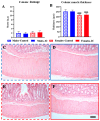Ex Vivo Study of Colon Health, Contractility and Innervation in Male and Female Rats after Regular Exposure to Instant Cascara Beverage
- PMID: 39200401
- PMCID: PMC11353626
- DOI: 10.3390/foods13162474
Ex Vivo Study of Colon Health, Contractility and Innervation in Male and Female Rats after Regular Exposure to Instant Cascara Beverage
Abstract
Instant Cascara (IC) is a sustainable beverage made from dried coffee cherry pulp, a by-product of coffee processing. It is rich in nutrients and bioactive compounds and has a high concentration of antioxidants. This study explored the impact of regular IC consumption on colonic motor function and innervation. Over a period of 4 weeks, male and female healthy rats were given drinking water containing 10 mg/mL of IC. Thereafter, colon samples were obtained to evaluate the longitudinal (LM) and circular (CM) smooth muscle contractile response to acetylcholine (ACh) and electrical field stimulation (EFS) in an organ bath, before and after atropine administration (10-6 M). Histological and immunohistochemical analyses assessed colon damage, muscle thickness, and immunoreactivity to substance P (SP) and neuronal nitric oxide synthase (nNOS). ACh and EFS induced similar responses across groups, but the CM response to EFS was greater in females compared with males, despite their lower body weight. Atropine completely blocked the response to ACh but only partially antagonized the neural response to EFS, particularly that of CM in females treated with IC, which had a greater liquid intake than those exposed to water. However, in the myenteric ganglia, no statistically significant differences were observed in SP or nNOS. Our results suggest that regular IC exposure may enhance specific neural pathway functions, particularly in females, possibly due to their increased IC consumption.
Keywords: Instant Cascara; antioxidants; coffee by-products; colon contractility; muscarinic receptors; myenteric plexus; organ bath; rat; sex; substance P.
Conflict of interest statement
The authors declare no conflicts of interest.
Figures











References
Grants and funding
LinkOut - more resources
Full Text Sources

